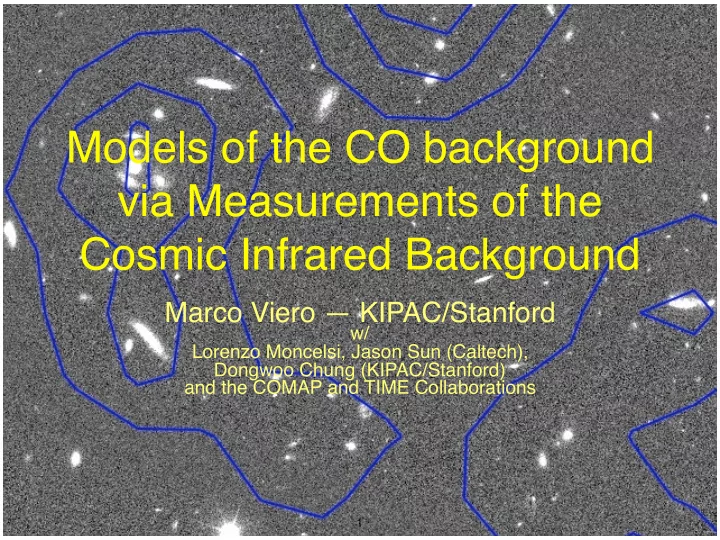

Models of the CO background via Measurements of the Cosmic Infrared Background Marco Viero — KIPAC/Stanford w/ Lorenzo Moncelsi, Jason Sun (Caltech), Dongwoo Chung (KIPAC/Stanford) and the COMAP and TIME Collaborations 1
Motivation: Typical CO Model Design Tony Li et al. 2016 Not all halos the same ( assembly bias): Add scatter . Not all galaxies star-forming: Add scatter . 2 marco.viero@stanford.edu Intensity Mapping Meeting — JHU — June 13 2017
Motivation: Typical CO Model Design Tony Li et al. 2016 Stellar Mass — M * Use empirically derived L IR (z,M * ) 3 marco.viero@stanford.edu Intensity Mapping Meeting — JHU — June 13 2017
Challenge • Infrared/Submillimeter emission reprocessed starlight by dust • IR/Submm traces star formation • Half the emission is tied up in dust • Want to know: ➡ what about the Optical SED predicts the Thermal Infrared LIR GOODS-S Half 1 da Cunha+2010 marco.viero@stanford.edu Intensity Mapping Meeting — JHU — June 13 2017 4
Challenge: Source Confusion z-band 250um Optical v. Infrared Background marco.viero@stanford.edu Intensity Mapping Meeting — JHU — June 13 2017 5
Solution Use: • The fact that intensity fluctuations contain signal • Ancillary Data • Creativity + Statistics GOODS-S GOODS-S Half 1 Half 2 marco.viero@stanford.edu Intensity Mapping Meeting — JHU — June 13 2017 6
Optical v. Infrared Background SPIRE Contour • Half the emission is tied up in dust • ad • Difficult to attribute an individual submillimeter “source” to any single galaxy 7
Optical v. Infrared Background SPIRE Contour • Half the emission is tied up in dust • ad • Key is to identify galaxies with similar physical properties, and then rely on statistics to fit fluctuations 8
SIMSTACK: Simultaneous Stacking Algorithm make hits map from catalog of similar objects convolve with instrument p.s.f. regress to find mean flux density, S Formalism developed w/ Lorenzo Moncelsi (Caltech); also see Kurczynski & Gawiser (2010), Roseboom et al. (2010) SIMSTACK code publicly available (see arXiv:1304.0446): IDL (old) — https://web.stanford.edu/~viero/downloads.html Python — https://github.com/marcoviero/simstack marco.viero@stanford.edu Intensity Mapping Meeting — JHU — June 13 2017 9
SIMSTACK: Simultaneous Stacking Algorithm × S 1 ➜ bin 1 + × S 2 ➜ bin 2 + …� + … × S N ➜ bin N ≈ Formalism sky developed w/ Lorenzo Moncelsi map (Caltech) SIMSTACK code publicly available (see arXiv:1304.0446): Python — https://github.com/marcoviero/simstack marco.viero@stanford.edu Intensity Mapping Meeting — JHU — June 13 2017 10
M = 9.5-10 z=1.0 to 1.5 X Y 996 1009 55 1011 187 1010 × S 1 ➜ 501 1011 336 1012 127 1011 … + M = 10-10.5 X Y 535 1026 345 1029 340 1029 ≈ × S 2 517 1027 ➜ 805 1031 805 1031 … + …� + … M = 10.5-11 X Y 345 1029 340 1029 517 1027 ➜ × S N 805 1031 805 1031 238 1032 359 1033 841 1034 … 11
SIMSTACK: Flux Densities (M,z) Each circle one bin Data here: UDS catalog & Herschel SPIRE maps marco.viero@stanford.edu Intensity Mapping Meeting — JHU — June 13 2017 12
SIMSTACK: SEDs Flux Density [mJy] Viero, Moncelsi, Quadri+ (2013) arXiv:1304.0446 marco.viero@stanford.edu Intensity Mapping Meeting — JHU — June 13 2017 13
SIMSTACK: SEDs redshift slices stellar mass slices marco.viero@stanford.edu Intensity Mapping Meeting — JHU — June 13 2017 14
SIMSTACK: L IR (M,z,…) redshift slices Assuming only L(M,z), • { i.e.; star-forming main sequence stellar mass slices marco.viero@stanford.edu Intensity Mapping Meeting — JHU — June 13 2017 15
SIMSTACK: L IR (M,z,Av,Fagn) marco.viero@stanford.edu Intensity Mapping Meeting — JHU — June 13 2017 16
SIMSTACK: L IR (M,z,Av,Fagn) SPIRE 250um Simulated preliminary marco.viero@stanford.edu Intensity Mapping Meeting — JHU — June 13 2017 17
SIMSTACK: L IR (M,z,Av,Fagn) marco.viero@stanford.edu Intensity Mapping Meeting — JHU — June 13 2017 18
Applications • Signal ➡ Connect to Halo properties (including assembly bias) to: ‣ estimate CO levels, ‣ construct covariances, ‣ test different estimators (i.e., beyond power spectrum), ‣ Details being discussed during this meeting! ➡ Extend to other lines that correlate with thermal dust SED ‣ CII, OII, OIII, NII ‣ r.f. 850um as tracer of ISM Mass. • Foregrounds ➡ Predict CO contamination in CII data cubes (e.g, Sun and the TIME collaboration, 2017) marco.viero@stanford.edu Intensity Mapping Meeting — JHU — June 13 2017 19
Masking CO in CII line-intensity maps • Targeting CII at z = 6-10 means separating signal from lower-z CO. • In deep fields (e.g., COSMOS, UDS, GOODS), all potentially significant CO emitters (z=1-3) will be cataloged in the UV, optical, and NIR with great detail. ➡ In these cases, we can construct an estimator for CO from optical predictors of the mean LIR. ➡ How much variance is there from the mean, and how aggressively does masking need to be to play it safe? marco.viero@stanford.edu Intensity Mapping Meeting — JHU — June 13 2017 20
Masking CO in CII data: Sun et al. 2017 Variance in the LIR estimator determined by comparing scatter in the difference map with simulations. • Find sigma = 0.33 Guaocho (Jason) Lorenzo Moncelsi Sun Sun, Moncelsi, Viero & TIME collaboration 2017, arXiv:1610.10095 marco.viero@stanford.edu Intensity Mapping Meeting — JHU — June 13 2017 21
Masking CO in CII data: Sun et al. 2017 Sun, Moncelsi, Viero & TIME collaboration 2017, arXiv:1610.10095 marco.viero@stanford.edu Intensity Mapping Meeting — JHU — June 13 2017 22
Summary • CIB continuum intensities are key to empirically connecting optical features of typical galaxies to their FIR/submm components • Applications for this model include: ➡ Forecasting CO power for: ‣ Survey design ‣ Covariance construction ‣ Testing Estimators ‣ Measurement Interpretation • For this workshop, would like to… ➡ Determine how best to populate halos ➡ Explore Estimators • SIMSTACK is easy to use, and available at: ➡ https://github.com/marcoviero/simstack marco.viero@stanford.edu Intensity Mapping Meeting — JHU — June 13 2017 23
Recommend
More recommend